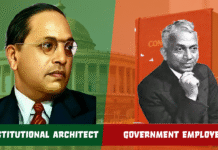Mangu Ram Mugowalia: Pioneer of Downtrodden Liberation and the Ad Dharm Movement
Mangu Ram Mugowalia (1886-1980) stands as one of the most significant yet underappreciated figures in India’s struggle for both national independence and social justice. A pioneering leader who bridged the anti-colonial Ghadar movement in America with the downtrodden (Dalit) liberation struggle in Punjab, Mugowalia’s life exemplifies the interconnected nature of political freedom and social emancipation. His foundational role in establishing the Ad Dharm movement in 1926 created the first major organized resistance to caste oppression in North India, fundamentally reshaping downtrodden (Dalit) consciousness and political assertion in the region. Through his visionary leadership, Mugowalia not only challenged the colonial state but also confronted the deeply entrenched Braman (priest) social order that relegated millions to the margins of society.

Timeline of Major Events in Mangu Ram Mugowalia’s Life (1886-1980)
Early Life and the Crucible of Caste Discrimination
Born on January 14, 1886, in the village of Mugowal in Hoshiarpur district, Punjab, Mangu Ram was born into a Chamar family to parents Harman Dass and Atri. His father had departed from the traditional leather-working occupation of his caste and instead found employment supplying leather materials for military boots at the Jalandhar cantonment, providing the family with relatively better economic circumstances than many of their caste peers. This economic stability, however, could not shield young Mangu Ram from the harsh realities of caste-based discrimination that would profoundly shape his worldview and future activism. [1][2]
The trajectory of Mugowalia’s early education reveals the systematic exclusion and humiliation that downtrodden (Dalit) children faced in colonial Punjab’s educational institutions. Initially taught by a village saint (Sadhu) until the age of seven, he subsequently attended schools in the Mugowal area and later in Dehradun. In most educational institutions, Mangu Ram was often the only downtrodden (Dalit) student, forced to endure practices that reinforced his “untouchable” status. The educational apartheid manifested in multiple forms: he was compelled to sit at the back of classrooms or in separate rooms, listening to lessons through open doors. When attending high school in Bajwara, he was forced to remain outside the building entirely, receiving instruction through windows.[2][1]
A particularly traumatic incident epitomized the dehumanizing nature of untouchability in educational settings. During a severe hailstorm, when Mangu Ram sought shelter inside the classroom, the Brahmin (priest) teacher not only beat him severely but also had all classroom furniture that he had “polluted” by his presence carried outside into the rain for ritual purification. This incident, emblematic of the daily humiliations faced by downtrodden (Dalit) students, effectively ended his formal education despite his academic potential—he had ranked third in his primary school class. [1][2]
While his dominant-caste classmates were encouraged to pursue careers as patwaris (village record-keepers) or seek higher education, Mangu Ram was advised to abandon his studies and assist his father in what was considered a more “appropriate” occupation for someone of his caste. The contrast between potential and societal limitations would later fuel his determination to challenge the entire caste system that denied dignity and opportunity to millions based solely on birth. [1]

Birth anniversary of Babu Mangu Ram Mugowalia, founder of the Ad-Dharmi Movement for equality of Untouchables.
The American Sojourn and Ghadar Party Involvement
In 1909, following the pattern of many young men from the Doaba region seeking better economic opportunities, Mangu Ram emigrated to the United States, settling in California. His father’s relative prosperity from the military supply business enabled this journey, which was undertaken with hopes of financial betterment. Initially, Mangu Ram worked in the agricultural sector, laboring in peach orchards in Fresno and other locations in California’s San Joaquin Valley, as well as in the lumber industry. [1][3][4][5]
However, even in America, the shadow of caste discrimination followed him. Ironically, he found himself working on farms owned by Punjabi zamindars (landlords) who had settled in California, where caste-based prejudices were replicated in the diaspora community. This experience reinforced his understanding that geographical displacement alone could not solve the fundamental problem of social hierarchy and discrimination. [5]
The transformative aspect of his American experience came through his involvement with the Ghadar Party, a revolutionary organization established in 1913 by expatriate Indians committed to armed struggle against British colonial rule. The party, led by figures like Lala Hardyal and Sohan Singh Bhakna, attracted Mangu Ram through its radical anti-colonial ideology and its relatively egalitarian treatment of members regardless of their caste background. This exposure to equality within the Ghadar movement profoundly influenced his later vision for a casteless society. [4][6][1][5]
Mangu Ram’s commitment to the Ghadar cause led to his involvement in one of the movement’s most dangerous operations in 1915. He was assigned a crucial role in a weapons smuggling mission designed to transport arms to India via ship to support the armed struggle against British rule. However, British intelligence had infiltrated the operation, and the mission ended in disaster when the ship carrying weapons was destroyed by British forces in international waters. While his four fellows Ghadarites perished in the operation, Mangu Ram miraculously survived, though he was captured and initially sentenced to death. [7][8][6]
The news of the failed mission and reports of his death reached his village in Punjab, where, according to community tradition, his wife Piari was married to his elder brother. Mangu Ram’s survival and subsequent years of living in hiding across various countries—including the Philippines and Sri Lanka—before finally returning to India in 1925 reads like an adventure tale, yet it was driven by his unwavering commitment to both national liberation and social justice. [8][7][5]
Return to India and the Genesis of Ad Dharm
When Mangu Ram returned to Punjab in 1925 after sixteen years abroad, he encountered an India still under colonial rule and a Punjab where caste-based discrimination remained as entrenched as ever. His American experience had exposed him to principles of equality and human dignity that starkly contrasted with the rigid hierarchical structures of Indian society. This exposure, combined with his traumatic childhood experiences of caste discrimination, crystallized his resolve to challenge not just colonial rule but also the indigenous systems of oppression that relegated downtrodden (Dalits) to subhuman status.[1][9]
Initially, Mangu Ram attempted to work within existing reform movements, particularly the Arya Samaj, which had shown some interest in downtrodden (Dalit) upliftment. However, he soon became disillusioned with what he perceived as the paternalistic attitude of these organizations, which sought to “purify” downtrodden (Dalits) to make them acceptable within Hindu fold rather than recognizing their inherent dignity and rights. This dissatisfaction led him to envision a more radical alternative—a separate religious and social identity for downtrodden (Dalits) that would restore their self-respect and provide a foundation for political mobilization. [10][1]
Late in 1925, Mangu Ram established the Ad Dharm School in his native village of Mugowal, creating the first educational institution specifically designed for downtrodden (Dalit) children in the region. This school served multiple purposes: it provided education to children who faced discrimination in mainstream institutions, and it became the physical and ideological space where the Ad Dharm movement would be conceived and launched. [11][1]
The formal inauguration of the Ad Dharm movement took place on June 11-12, 1926, in a historic gathering at the same school. Thousands of people belonging to 36 different castes traditionally labeled as “untouchable” converged from across Punjab, Rajasthan, Uttar Pradesh, Delhi, and Bengal to participate in this unprecedented assembly. The choice of dates and location was symbolic—the movement was born in the very village where Mangu Ram had experienced some of his most humiliating encounters with caste discrimination, transforming a site of personal trauma into a beacon of collective resistance. [12][9][11][10]
The foundational meeting established several revolutionary principles that distinguished Ad Dharm from other contemporary reform movements. Most significantly, the assembly declared that the participants constituted a separate “qaum” (religious community), distinct from Hindus, Sikhs, Muslims, and Christians. This assertion of separate religious identity was not merely symbolic but had profound political implications, as it positioned downtrodden (Dalits) as an independent community with distinct interests rather than a disadvantaged section of Hindu society. [13][12]
Ideological Foundations and Religious Innovation
The Ad Dharm movement’s ideological framework represented a sophisticated synthesis of historical reinterpretation, religious innovation, and political strategy. At its core lay Mangu Ram’s revolutionary assertion that downtrodden (Dalits) were not degraded Hindus but rather the “Moolnivasis” (original inhabitants) of the Indian subcontinent. This narrative completely inverted the traditional justification for untouchability, which portrayed downtrodden (Dalits) as inherently impure and deserving of their low status. [13][12]
According to the Ad Dharm ideology, the contemporary caste hierarchy resulted from the conquest and subjugation of indigenous peoples by foreign Aryan invaders. These alien conquerors, according to Mugowalia’s formulation, not only deprived the native population of their kingdoms and resources but also systematically enslaved them through the imposition of the chaturvarna (four-fold caste) system. The downtrodden (Dalits), in this interpretation, were not the lowest caste within Hindu society but rather the dispossessed rightful owners of the land, reduced to servitude through historical injustice. [14][13]
This reframing had enormous psychological impact on downtrodden (Dalit) communities across Punjab. Rather than accepting their marginalization as divinely ordained or the result of karmic debt from past lives—as traditional Hindu ideology suggested—Ad Dharm followers could view themselves as the victims of historical injustice who were entitled to reclaim their rightful place in society. The movement thus provided both a critique of existing power structures and a positive foundation for downtrodden (Dalit) identity and self-assertion. [3][13]
The religious dimensions of Ad Dharm drew heavily from the North Indian Bhakti tradition, particularly the teachings of saint-poets who had challenged caste hierarchy and Brahmanical orthodoxy. Guru Ravidas, the 15th-century saint-poet and contemporary of Kabir, occupied the central position in the Ad Dharm pantheon. Ravidas, himself born into a Chamar family, had articulated a vision of spiritual equality and social justice that resonated powerfully with the movement’s goals. [12][3]

Historical painting showing a spiritual teacher under a tree with a devotee in medieval Indian style.
The Ad Dharm movement also venerated other Bhakti saints including Maharishi Valmiki (traditionally regarded as the author of the Ramayana), Sant Kabir, and Sant Namdev. These figures were presented not as Hindu saints who happened to critique caste hierarchy, but as the original gurus of the Ad Dharm religion whose teachings had been appropriated and distorted by Brahmanical Hinduism. This religious framework provided Ad Dharm followers with their own sacred texts, rituals, and spiritual heritage independent of Hindu traditions. [12][15]
The movement adopted distinctive symbols and practices to reinforce its separate identity. The slogan “Jai Guru Dev” became the standard greeting among Ad Dharmis, replacing traditional Hindu salutations. The symbol “Soham” was adopted as a sacred mark, and the movement had its own flag and religious calendar. These external markers of identity were crucial in creating a sense of community among disparate downtrodden (Dalit) castes who had previously been divided by regional, occupational, and sub-caste differences. [15]

Artistic depiction of a saintly figure resembling traditional portrayals of Guru Ravidas with a halo symbolizing divinity.
Political Strategy and Electoral Triumph
The Ad Dharm movement’s political strategy demonstrated Mangu Ram’s sophisticated understanding of colonial administrative structures and electoral politics. The movement’s most significant strategic achievement was securing recognition of Ad Dharm as a separate religion in the 1931 Census. This recognition was not merely symbolic—it had profound implications for political representation under the colonial system of communal electorates. [1][14]
Mangu Ram’s timing proved masterful. The 1930s were a crucial decade for Indian politics, with the British government conducting Round Table Conferences in London to discuss constitutional reforms. During these negotiations, the question of downtrodden (Dalit) representation became a contentious issue between Mahatma Gandhi, who claimed to represent all Hindus including downtrodden (Dalits), and Dr. B.R. Ambedkar, who argued for separate political representation for downtrodden (Dalits). [13][16]
The Ad Dharm movement provided crucial support to Dr. Ambedkar’s position by demonstrating that significant sections of the downtrodden (Dalit) population did not consider themselves Hindu and therefore could not be represented by Gandhi or the Congress Party. Mangu Ram personally sent multiple telegrams to London supporting Ambedkar’s demand for separate electorates for downtrodden (Dalits), providing evidence of grassroots downtrodden (Dalit) support for political independence from Hindu leadership. [17][16][13]
The political dividends of this strategy became evident in the 1937 provincial elections, the first major elections held under the Government of India Act of 1935. The Ad Dharm movement achieved remarkable success, winning 7 out of 8 reserved seats for Scheduled Castes in the Punjab Legislative Assembly. This represented an 87.5% success rate in constituencies specifically designated for downtrodden (Dalit) representation, demonstrating the movement’s deep roots in the community and its effective mobilization of downtrodden (Dalit) voters. [12][14]

Ad Dharm Movement’s Electoral Success in Punjab Legislative Assembly (1937 & 1946)
This electoral triumph was unprecedented in the history of downtrodden (Dalit) politics in North India. It proved that given proper organization and leadership, downtrodden (Dalit) communities could successfully challenge both the colonial state and indigenous elite groups through democratic means. The success also validated Mangu Ram’s strategy of separate political identity—rather than seeking accommodation within existing political frameworks, the Ad Dharm movement had created its own political space and demonstrated its electoral viability. [14]
The movement’s political influence continued into the 1946 provincial elections, where it maintained significant representation in the Punjab Legislative Assembly. Mangu Ram himself was elected to the Assembly in 1946, providing him with a platform to advocate for downtrodden (Dalit) rights and interests in the crucial period leading up to Indian independence. [1][18][14]
Relationship with Dr. B.R. Ambedkar and National Dalit Leadership
The relationship between Mangu Ram Mugowalia and Dr. B.R. Ambedkar represents one of the most significant yet underexplored alliances in the history of the Indian downtrodden (Dalit) movement. Despite operating in different regions—Ambedkar primarily in Maharashtra and Mangu Ram in Punjab—the two leaders developed a mutually supportive relationship based on shared commitment to downtrodden (Dalit) liberation and similar analysis of the structural nature of caste oppression.
The collaboration became particularly evident during the crucial London Round Table Conferences of the early 1930s, when the question of downtrodden (Dalit) political representation emerged as a central issue in constitutional negotiations. While Gandhi claimed to represent all Hindus including downtrodden (Dalits), Ambedkar argued that downtrodden (Dalits) constituted a distinct community requiring separate political representation. The Ad Dharm movement’s position as a separate religion provided powerful evidence supporting Ambedkar’s argument. [13][16]
Mangu Ram’s support for Ambedkar during this period was both strategic and principled. He recognized that the success of downtrodden (Dalit) liberation movements in different regions of India was interconnected—a victory for separate electorates at the national level would strengthen regional movements like Ad Dharm, while successful regional mobilization demonstrated the viability of downtrodden (Dalit) political independence. The telegrams sent by Mangu Ram to London supporting Ambedkar’s position represented more than symbolic solidarity; they provided concrete evidence of grassroots downtrodden (Dalit) support for autonomous political representation. [17][16][13]
The relationship between the two leaders was not without its complexities, particularly regarding the Poona Pact of 1932. When Gandhi undertook a fast unto death to oppose separate electorates for downtrodden (Dalits), immense pressure was placed on Ambedkar to compromise. The resulting Poona Pact replaced separate electorates with reserved seats within the general electorate—a significant dilution of the original demand. Some contemporary observers suggested that this compromise created tensions between Ambedkar and regional leaders like Mangu Ram who had strongly supported separate electorates.[16]
However, available evidence suggests that Mangu Ram continued to regard Ambedkar as the paramount leader of the downtrodden (Dalit) movement even after the Poona Pact. This loyalty reflected both personal respect for Ambedkar’s intellect and leadership and a pragmatic recognition that united downtrodden (Dalit) leadership was essential for effective resistance to caste oppression. The Ad Dharm movement’s continued support for Ambedkar’s broader political initiatives, including the formation of the All India Scheduled Castes Federation, demonstrated the enduring nature of their alliance. [16]
The collaboration between Mugowalia and Ambedkar also had significant implications for the development of downtrodden (Dalit) political consciousness in Punjab. The Ad Dharm movement provided fertile ground for the dissemination of Ambedkar’s ideas and writings among Punjabi downtrodden (Dalits), many of whom might otherwise have remained isolated from national downtrodden (Dalit) intellectual and political currents. Conversely, the success of the Ad Dharm movement demonstrated to Ambedkar and other national leaders the potential for effective downtrodden (Dalit) political mobilization in regions beyond Maharashtra. [13]
Social and Cultural Transformation
Beyond its political achievements, the Ad Dharm movement initiated a profound transformation in downtrodden (Dalit) social and cultural consciousness across Punjab. The movement’s impact extended far beyond electoral politics, fundamentally altering how downtrodden (Dalit) communities understood their place in society and their relationship to dominant social groups.
One of the movement’s most significant contributions was the creation of alternative social institutions that challenged the exclusion of downtrodden (Dalits) from mainstream society. The network of Ad Dharm schools established across Punjab provided education to downtrodden (Dalit) children who faced discrimination in government and private institutions. These schools not only imparted literacy and numeracy but also taught pride in downtrodden (Dalit) history and heritage, countering the negative self-image that centuries of social oppression had internalized within the community. [1][19]
The movement also established its own religious and cultural practices, creating spaces where downtrodden (Dalits) could worship and celebrate without facing the humiliation and exclusion they experienced in Hindu temples and Sikh gurdwaras. Ad Dharm mandirs (temples) and gathering places provided venues for community meetings, religious observances, and cultural events that reinforced the movement’s separate identity while fostering solidarity among different downtrodden (Dalit) sub-castes.[12]
The publication activities of the Ad Dharm movement played a crucial role in developing downtrodden (Dalit) intellectual culture in Punjab. The movement’s periodical, “Adi Danka,” served multiple functions: it disseminated the movement’s ideology, provided news about downtrodden (Dalit) communities across Punjab and beyond, and created a platform for downtrodden (Dalit) writers and thinkers to express their views. This publication represented one of the first sustained efforts to create downtrodden (Dalit)-controlled media in North India, challenging the monopoly of dominant-caste perspectives in print culture. [17]
The movement’s cultural impact was particularly evident in its reinterpretation of Punjab’s religious and social history. By placing figures like Guru Ravidas at the center of their discourse, the Ad Dharm movement reclaimed these saints as specifically downtrodden (Dalit) spiritual leaders rather than universal Hindu or Punjabi cultural figures. This reclamation provided downtrodden (Dalit) communities with their own pantheon of heroes and role models, countering the dominant narrative that portrayed worthiness and achievement as the exclusive domain of dominant castes. [3][12]
The transformation of downtrodden (Dalit) self-perception was perhaps the movement’s most lasting achievement. Generations of downtrodden (Dalits) had internalized the social messaging that they were inherently impure, spiritually degraded, and deservingly marginalized. The Ad Dharm ideology directly challenged these internalizations by presenting downtrodden (Dalits) as the rightful inheritors of the land, victims of historical injustice rather than bearers of spiritual deficiency. This reframing had profound psychological and social implications, enabling downtrodden (Dalit) communities to organize, assert their rights, and resist oppression with greater confidence and unity. [13]
Legacy and Historical Significance
The Ad Dharm movement under Mangu Ram Mugowalia’s leadership established several important precedents that influenced subsequent downtrodden (Dalit) political mobilization across India. The movement’s strategy of asserting separate religious identity as a foundation for political autonomy provided a template that other regional downtrodden (Dalit) movements would adapt and modify according to their specific contexts.
The movement’s electoral success demonstrated that downtrodden (Dalit) political mobilization could achieve concrete results within democratic frameworks, challenging both colonial administrators and indigenous political parties to take downtrodden (Dalit) demands seriously. The 87.5% success rate in reserved constituencies in 1937 proved that effective organization and clear ideological articulation could translate into political power, providing inspiration for downtrodden (Dalit) political efforts in other regions. [14]
Mangu Ram’s approach to leadership also established important precedents for downtrodden (Dalit) political organization. Unlike some contemporary leaders who sought accommodation within existing political parties or movements, Mangu Ram insisted on autonomous downtrodden (Dalit) political organization with independent leadership. This approach reflected his understanding that meaningful social change required downtrodden (Dalits) to control their own political destiny rather than depending on the benevolence of dominant-caste leaders. [6]
The movement’s decline after Indian independence in 1947 reflected broader challenges facing downtrodden (Dalit) political organizations during the transition to democratic governance. The integration of princely states, the partition of Punjab, and the reconfiguration of electoral systems created new challenges that the Ad Dharm movement struggled to navigate. Many of its leaders and supporters were absorbed into national political parties or Dr. Ambedkar’s Republican Party, diluting the movement’s independent political identity. [20][16]
However, the movement’s influence extended far beyond its organizational lifespan. The principles and strategies pioneered by Mangu Ram continued to influence downtrodden (Dalit) political movements in Punjab and beyond throughout the post-independence period. Contemporary downtrodden (Dalit) political parties and organizations can trace intellectual and strategic lineages back to the Ad Dharm movement’s innovations in identity assertion, political mobilization, and electoral strategy. [21]
Academic recognition of the movement’s significance came through the pioneering research of scholars like Mark Juergensmeyer, whose work “Religious Rebels in the Punjab” brought the Ad Dharm movement to broader scholarly attention. This academic engagement helped preserve the historical record of the movement and highlighted its importance in the broader context of Indian social and political history. [13][21]
The movement’s legacy is also evident in the continued political mobilization of downtrodden (Dalit) communities in contemporary Punjab. Modern downtrodden (Dalit) political organizations, while operating in changed contexts, continue to employ strategies of identity assertion, autonomous organization, and electoral mobilization that were pioneered by the Ad Dharm movement. The movement’s emphasis on pride in downtrodden (Dalit) heritage and resistance to caste-based discrimination remains relevant in addressing contemporary forms of social oppression. [21]
Recognition and Later Years
Despite his monumental contributions to both the Indian independence movement and downtrodden (Dalit) liberation, Mangu Ram Mugowalia received limited recognition during his lifetime. This oversight reflected broader patterns of historical marginalization that relegated downtrodden (Dalit) leaders to secondary status in nationalist narratives, despite their significant contributions to both anti-colonial struggle and social transformation.
Official recognition finally came in 1972 when Prime Minister Indira Gandhi awarded Mangu Ram a pension and an honor in recognition of his contributions to the independence movement. This belated acknowledgment was significant not only for Mangu Ram personally but also as a symbolic recognition of the downtrodden (Dalit) contribution to Indian freedom struggle, which had often been overlooked in mainstream historical accounts. [1][4]
The award ceremony and subsequent publicity helped bring Mangu Ram’s story to wider public attention, introducing new generations to the history of the Ad Dharm movement and its significance in the broader struggle for social justice. However, this recognition also highlighted the decades of neglect that had allowed the contributions of leaders like Mangu Ram to remain largely unknown outside their immediate communities. [17]
Mangu Ram continued his involvement in social and political causes until his advanced age, serving as an elder statesman and source of inspiration for younger downtrodden (Dalit) activists. His longevity—he lived to the age of 94—allowed him to witness the dramatic changes in Indian society during the post-independence period, including the implementation of affirmative action policies and the gradual expansion of educational and economic opportunities for downtrodden (Dalit) communities. [9]
His death on April 22, 1980, marked the end of an era in Punjab’s social and political history. The passing of this last surviving founder of the Ad Dharm movement represented the conclusion of a chapter that had begun with his birth during the height of colonial rule and had encompassed experiences ranging from California’s fields to Punjab’s legislative assembly, from revolutionary weapons smuggling to electoral politics, from personal encounters with caste discrimination to leading a mass movement for social transformation. [1]
Conclusion
Mangu Ram Mugowalia’s life and work represent a unique synthesis of anti-colonial nationalism and social revolutionary activism that challenges conventional boundaries in Indian historical analysis. His trajectory from a discriminated downtrodden (Dalit) child in colonial Punjab to a founder member of the Ghadar Party in America, and subsequently to the architect of one of North India’s most significant downtrodden (Dalit) liberation movements, exemplifies the interconnected nature of different forms of oppression and resistance.
The Ad Dharm movement’s achievements under Mangu Ram’s leadership demonstrated that effective social change required both ideological innovation and practical political organization. The movement’s success in creating a positive alternative identity for downtrodden (Dalit) communities, mobilizing them for political action, and achieving concrete electoral victories established important precedents for subsequent downtrodden (Dalit) political mobilization across India. The movement’s emphasis on autonomous leadership, separate institutional development, and pride in downtrodden (Dalit) heritage provided a template that continues to influence contemporary social movements. [13][12]
Perhaps most significantly, Mangu Ram’s life challenges the artificial separation often made between national liberation and social emancipation in Indian history. His seamless transition from anti-British revolutionary to downtrodden (Dalit) liberation leader reflected his understanding that political independence without social transformation would leave fundamental structures of oppression intact. This integrated vision of liberation—encompassing both freedom from colonial rule and freedom from caste-based discrimination—represents one of his most important intellectual contributions to Indian political thought. [6]
The relative neglect of Mangu Ram’s contributions in mainstream historical accounts reflects broader patterns of marginalization that have minimized the role of downtrodden (Dalit) leaders in Indian national and social movements. Recent scholarly attention to figures like Mangu Ram represents an important corrective to these omissions, highlighting the diversity of leadership and perspective within India’s liberation movements. [6]
As contemporary India continues to grapple with issues of social inequality, discrimination, and marginalization, the example of leaders like Mangu Ram Mugowalia remains highly relevant. His demonstration that oppressed communities can organize effectively, assert their rights, and achieve meaningful political representation provides inspiration for ongoing struggles for social justice. The principles and strategies he pioneered—autonomous organization, positive identity assertion, and strategic electoral engagement—continue to inform contemporary social movements seeking to challenge structural inequality. [21]
The life of Mangu Ram Mugowalia ultimately represents the possibility of transformation—both personal and social—through organized struggle and visionary leadership. From the fields of California to the villages of Punjab, from revolutionary conspiracy to electoral politics, from personal humiliation to collective empowerment, his journey embodies the potential for individuals and communities to overcome seemingly insurmountable obstacles through determination, strategic thinking, and unwavering commitment to justice. His legacy serves as both a historical record of past achievements and a source of inspiration for continuing struggles against oppression in all its forms.
- https://en.wikipedia.org/wiki/Mangu_Ram
- https://chakrafoundation.org/mangu-ram-mugowalia/
- https://www.forwardpress.in/2021/06/punjabs-ad-dharm-movement-which-turned-untouchables-into-proud-mulnivasis/
- https://parivrajaka.in/babu-mangu-ram-mugowalia/
- https://modernrationalist.com/mangu-ram-social-justice-stalwart-of-punjab/
- https://www.sikhphilosophy.net/threads/mangu-ram-muggowal-remembering-an-unsung-dalit-hero-of-the-ghadar-movement.39943/
- https://pa.wikipedia.org/wiki/ਮੰਗੂ_ਰਾਮ_ਮੁਗੋਵਾਲੀਆ
- https://www.ambedkartimes.com/Ambedkar Times-2-January 10, 2024.pdf
- https://www.roundtableindia.co.in/birth-anniversary-of-babu-mangu-ram-mugowalia/
- https://velivada.com/2019/08/22/ad-dharm-religion-of-the-untouchables-mangoo-ram-punjab/
- https://velivada.com/2015/06/11/11th-june-in-dalit-history-ad-dharm-movement-was-launched-by-babu-mangu-ram-mugowalia/
- https://iqac.puchd.ac.in/naac-docs/c3/publications/62f38440197068.50249999.pdf
- https://www.deshdoaba.com/wp-content/uploads/2021/04/Ambedkar-Times-21-April-2021_compressed.pdf
- http://www.ambedkartimes.com/Kempasiddaiah.htm
- https://ambedkartimes.com/babu_manguram.htm
- http://diplomatictitbits.blogspot.com/2013/01/babu-manguram-mugowalia-tribute-birth.html
- https://upkaar.com/essays/Ramesh-chander/2013/01-babu-manguram-ji-15012012.htm
- https://www.ambedkartimes.com/Ambedkar Times-50-December 11, 2024.pdf
- https://sabrangindia.in/article/how-ad-dharm-led-crusade-against-untouchability/
- https://journals.sagepub.com/doi/10.1177/006996670403800302
- https://www.forwardpress.in/2021/06/mark-juergensmeyers-research-reignited-dalit-consciousness-and-radical-assertion-in-punjab/
- https://www.ambedkartimes.com/babu_manguram.htm
- https://www.ambedkartimes.com/Ambedkar Times-36-September 3, 2025.pdf
- https://drambedkarbooks.com/2015/04/22/22nd-april-in-dalit-history-death-anniversary-of-babu-mangu-ram-mugowalia-founder-of-ad-dharmi-movement/
- https://drambedkarbooks.com/2015/01/14/14th-january-in-dalit-history-bday-of-babu-mangu-ram-mugowalia-founder-of-ad-dharmi-movement/
- https://www.ambedkartimes.com/Baba Mangu Ram Mugowalia.htm
- https://www.questjournals.org/jrhss/papers/vol10-issue7/Ser-2/1007266270.pdf
- https://iqac.puchd.ac.in/naac-docs/c3/publications/62f37f2ca48b56.81885284.pdf
- https://en.wikipedia.org/wiki/Ad-Dharmi
- https://www.instagram.com/p/CYvEFu3AJS_/
- https://en.wikipedia.org/wiki/Ghadar_Movement
- https://en.wikipedia.org/wiki/1937_Indian_provincial_elections
- https://vajiramandravi.com/upsc-exam/1937-election/
- https://en.wikipedia.org/wiki/1946_Indian_provincial_elections
- https://www.ambedkartimes.com/page19.html




















